Hi! We’re in the thick of the fall event season over here. Many of you are new to our newsletter, and so it feels like a good time to share what we’re all about – mainly, the basics of our sustainable floral design practice and how that compares to event industry status quo. And, to speak to the enduring question: are flowers for events wasteful?
This is a complex question.
Let me set the stage to answering this question by sharing some of the math and floral design realities that led me to launch a sustainable floral design business.
Events happen by the thousands per week in New York City. In 2022, there were a documented 15,079 weddings in Brooklyn alone (That’s ~289 per week!). In Manhattan last year, there were 38,749 (~745 per week)!! (The Wedding Report 2023).
Of course, the weekly event roster in NYC is not limited to weddings. There are milestone birthdays and anniversaries, engagements, gala fundraisers for non-profits, funerals, and all sizes of corporate events – from conferences and panels to expos and luncheons and executive meetings. In New York, there is always an occasion to celebrate and somewhere fabulous to celebrate it. (I recently finished a marathon re-watch of the OG Sex and the City, and Samantha’s constant use of “fabulous” has stuck, for now).
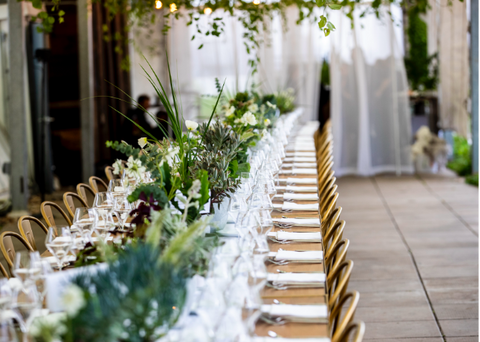
Our green tablescape design for a June 2019 corporate event for IBM on top of the Brooklyn Grange rooftop farm in the Brooklyn Navy Yard.
At each of these events, of course, are plenty of onetime-use items – food, signage, and decorations, including flowers. While there’s plenty more I could rant about in terms of event waste (don’t get me started on balloons), I’m going to stick with flowers.
Some events require more flowers, others less. Whatever the size, each event also requires a dozen or more vessels (usually in the range of 30 – 70) to hold the arrangements, transportation and package the arrangements, a team to set up, and a team to return to the venue and collect the flowers/arrangements and then… figure out what’s next.
Turns out, what happens next, by and large, is a LOT of waste. Recent Googling led me to a Huffpost.com article which cited that a wedding with 110 guests will generate up to 600 lbs. of waste. So, let’s assume 2/3s of the 15,000 weddings in Brooklyn were for 110 people. That is 6,000,000 lbs. of waste per year for Brooklyn weddings alone. 12,000,000 lbs./year from Manhattan weddings. Double gasp.
By waste, I mean stuff we put in garbage bags or dumpsters – which heads to a landfill. Landfills are one of the worst emitters of greenhouse gases. According to a Reuters report in 2002, landfill waste causes 11% of global methane emissions.
Here's where I’m coming from. I was born in 1981. My young mind and heart were imprinted with ‘Ferngully: The Last Rainforest’, Captain Planet, and Reduce/Reuse/Recycle. Since I was 10 or so, I’ve been worried about the environment. And so, when I decided to start a floral design business, I needed to shape it in a way that produced as little waste as possible. There seemed to be a void in the industry – save a few lone stars that were concerned with environmental impact. I was excited to give people a waste-conscious alternative.
It doesn’t surprise me that many prospective clients, not far from me in age, sent in inquiries prefaced with “I wasn’t going to have flowers, because they’re so wasteful…” I understand why that concern arises. And now as my clients are now 5 – 10 years younger than me, the generational concern about waste and the environmental impact of their event is even stronger.
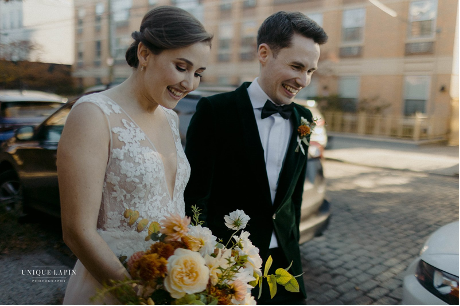
Most events last for 1 day or less, and flowers often don’t last much beyond that. The status quo for post-event clean-up has been to send flower arrangements home with guests (who wind up with a cabinet full of random glassware they hardly use) or they are sent to landfill (including whatever medium was used to support them inside the vase).
What’s inside the vase is most often Oasis floral “foam,” a non-biodegradable, toxic substance and known carcinogen: formaldehyde. And so, not only are organic, compostable materials being sent to landfills, but florists nation and world-wide had at some point in the 80 become dependent on a product that was a risk to their health as well as that of the environment. More on this an alternative mechanics down below!
Beyond single-use vessels, floral foam and lack of composting, there are other key ways the mainstream floral industry was utterly unsustainable: sourcing monoculture-grown flowers from countries thousands of miles away (reliant on long distance shipment via air cargo); depending on international floral agriculture hubs where labor and environmental protections are weak (mainly Colombia, Ecuador, Vietnam and elsewhere); the purchase of toxic, non-biodegradable paraffin wax candles by the hundreds per event; use of synthetic chemical sprays to preserve flowers’ vase life; use of sprayed / synthetically dyed flowers, feathers, and other products that do not biodegrade or can leach chemicals into the environment.
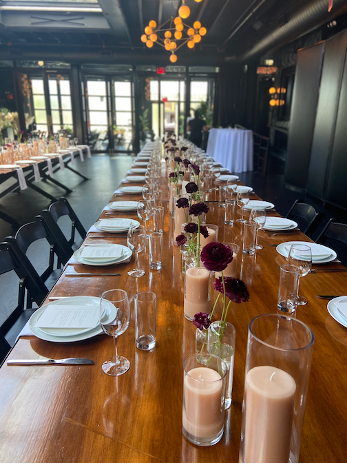
A wedding reception table at 501 Union in Gowanus, Brooklyn, featuring 100% custom-dyed beeswax candles that will be reused at future events.
If you’re still with me:
There are lots of ways we diverge from these mainstream tendencies. I’m happy to say I’m now surrounded by more than a few florists in Brooklyn who prioritize local flower sourcing, composting post-event, and use of alternative “mechanics” from floral foam.
While 80% of the flowers purchased by both florists and consumers today are grown overseas, we have always sourced 85%-100% of our flowers from small farmers within 200 miles. Sourcing has become more exciting every year, as flower farms have grown in number and scale, and bring new, amazing varieties to us. Working with local farmers helps us cut down on fossil fuel use, supports other small businesses, a local agricultural economy and green jobs.
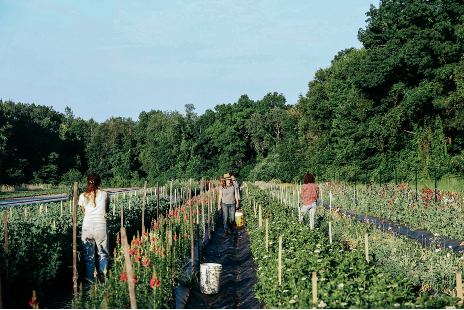
The Many Graces Farm in Hadley, MA is one of our main suppliers of locally-grown flowers.
Composting has always been a foundational practice. Compost boxes and buckets collect trimmings, brown kraft paper or newspaper – a perfect mix of Carbon and Nitrogen for successful composting. We have had a long-standing relationship with the Brooklyn Grange Rooftop Farm. Their Sunset Park farm is a 5 min. drive from our studio. On average, events generate 75 lbs. of compostable waste, and sometimes more. In an average year, we divert between 3,000 and 5,000 lbs. of organic waste from landfills.
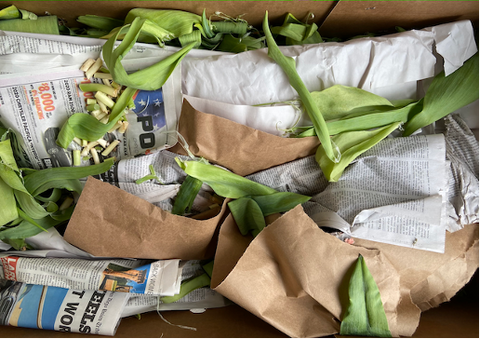
100% of our organic waste pre- and post-event goes to the Brooklyn Grange Rooftop Farm, and contributes to building new soil to grow vegetables and flowers.
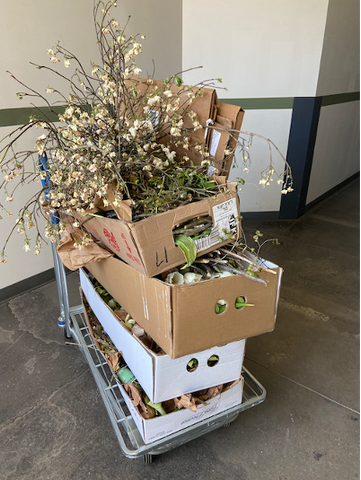
There’s also plenty of waste that comes our way that we do not have control over. Even some farmers continue to use soft plastic sleeves to bunch / transport their flowers. Wholesalers on 28th Street bundle bunches of foliage with nylon twine – not recyclable or compostable. Rubber bands by the thousands pass through our hands. Luckily, there's TerraCycle, an up-cycling company based in Princeton, NJ, that accepts lots of waste NYC’s recycling program currently cannot.
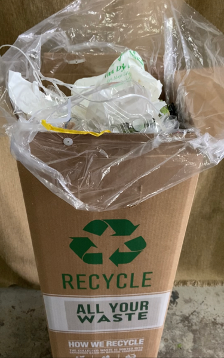
Our TerraCycle bins cost us around $3,000 a year. I feel it’s worth the investment. We can send any soft plastic flower sleeves, clean nylon twine, rubber bands, used / broken zip ties, etc. to them, and they’ll be separated and upcycled into park benches, kitchen counter compost bins, adirondack chairs, houseplant pots and more! It ensures more reuse, and lessens our trash output.
A big part of standard event waste are vessels / vases. It's common to see these thrown out with flowers post-event. We invest in returning at the end of the night, and recollecting our vessels. We keep a large inventory of vessels in a range of materials – some from local potters, which we love. We take good care of these, and occasionally add to the collection, and sell what we don’t use any more at a deep discount, often to other florists.
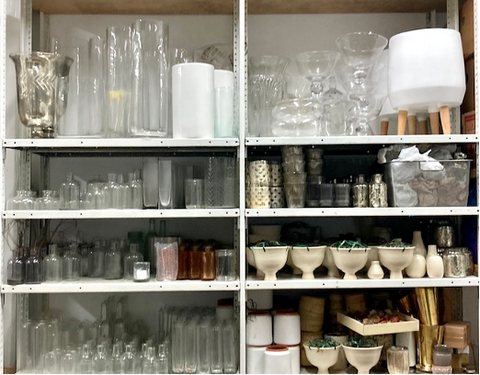
Last but not least are our designs themselves and what we use - besides flowers - to create them. If you're around my age, you likely recall receiving flower arrangements in the mail - or from a local florist - with a heavy green block turning to mush inside your vase. This is "floral foam". Floral foam was invented in 1954, and changed floral design drastically. Foam was widely adopted and used as a water-holding medium that enabled florists to insert and position stems in a particular way/angle. It made it possible for designs to stay hydrated for hours, and transported without water sloshing everywhere. Unfortunately, its key ingredient was formaldehyde, a cancer-causing toxic substance that does not biodegrade, and damages the health of florists, consumers and of our environment.
We've never used foam, and instead we use a variety of “mechanics” to support our designs. We use chicken wire, wedged inside vases and taped over; floral “frogs,” or Kenzan, a popular tool that looks like a metal pincushion created by the Japanese Ikebana floral tradition; and newer biodegradable foam-alternatives like ‘Agrawool,’ and ‘Oshun pouch,’ which are made with plant-based plastics, wools, coconut coir or mushroom fiber. These options hold water, allow for sculpting designs with precision, and DO biodegrade and/or are safe for composting.
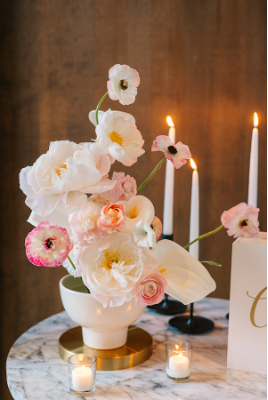
Ikebana-inspired design for a May 2023 wedding, at the Brooklyn Winery in Greenpoint, Brooklyn
Large scale installations are a fun challenge when it comes to developing a sustainable support system for the design. In the case below, we used a smaller-grade gold chicken wire mesh screen, and worked largely with flowers that didn’t require a water source:
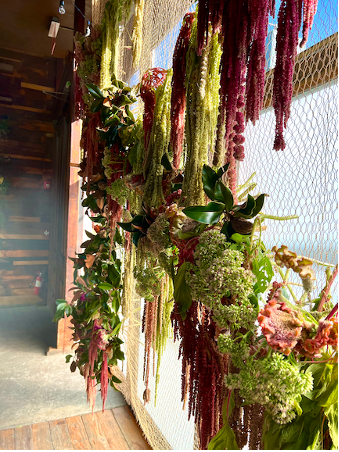
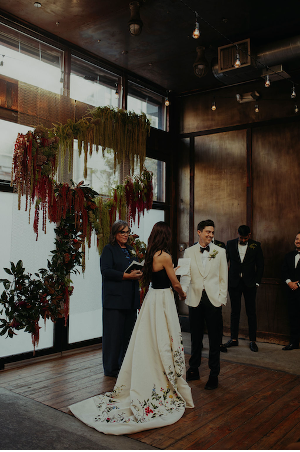
Arches, Chuppahs, and large arrangements are great places to use water tubes - small plastic tubes with holes for stems to stay hydrated. We'll "water tube" the most delicate flowers and often opt for foliage that can do well without water.
Vases small or large can be stuffed with chicken wire, and that chicken wire will provide enough structure for massive arrangements:


There are lots of little ways we try to reduce our impact – it usually starts with looking to source what we need as locally as possible, and to invest in items we know we will reuse again and again.
So, are flowers wasteful? They definitely can be – very wasteful. However if you find a florist – or any other vendor – that is dedicated to composting, local sourcing, and re-use, you can run or host an event with considerably less waste.
As for flowers… whether to use them in your event is up to you. There are many competing priorities when it comes to event budgets. A little can go a long way to bring a touch of aliveness and soul to an event. A good florist will help you narrow in on what matters to you, and help you put the budget you have towards the right items.
Hopefully, this post helps you see that flowers do not have to be. Your investment in working with a florist that sources local flowers means you end up also supporting small farm businesses, rural economies and green jobs. Most small flower farms use sustainable practices and avoid pesticides and herbicides. Their flowers are safe to grow, tend, harvest, design and compost. Flowers - especially seasonal flowers in their prime - bring joy and color to a space and experience. When you know the flowers were designed with as little impact as possible, and can be composted, sustainable flowers are one of the most eco-conscious ways to enliven and elevate an event, to create a mood, and stir a feeling or two.
To inquire about our services for an event, please head to our Inquire page. We’d love to work with you!

Comments
Ellison Williams said:
Such a resourceful read! Well-written, full of great facts, and very encouraging. Thanks for taking the time to share this valuable information! Your insights have inspired me to creatively repurpose wedding flowers. It’s a wonderful idea!
Jenni said:
So resourceful! We’ll written, great facts and very encouraging. Thanks for taking time out to share! Jenni